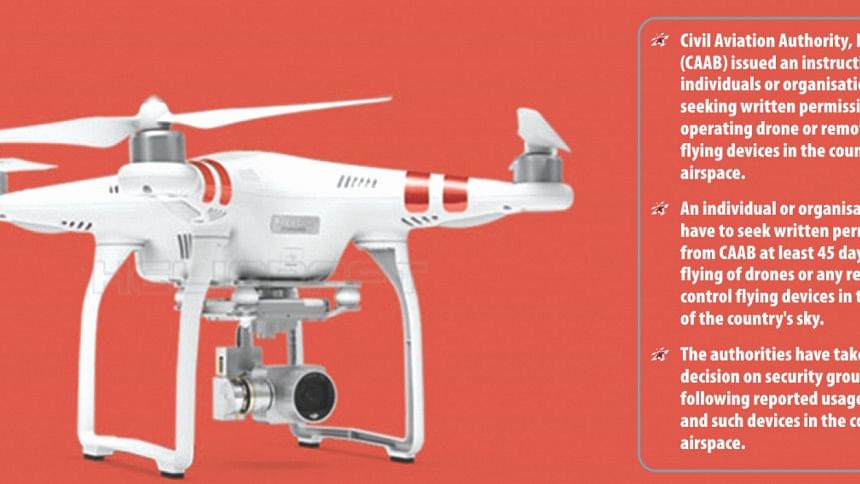DRONE IN BANGLADESH: Safety concerns and regulation

Like most of the ICT related innovations, positive and negative coverage on Unmanned Aerial Vehicles (UAV), Unmanned Aircraft Systems (UAS) or Remotely Piloted Aircraft Systems (RPAS) (popularly known as “drones”) in popular media is the recent regulatory concern for obvious reasons, even though they promise epoch-making deliverables. When conscious readers condemn the fatalities suffered by the civilians as a consequence of military drone attacks on terrorists, people are simultaneously fascinated to enjoy stunning photographs captured by using drones.
Drones are generally classified based on their propellers and purpose of use. Drones can bear heavy loads, contain camera, stabilizers and be equipped with or without GPS. Uses of drone in diversified activities e.g. from delivery of goods to photography, agricultural farming to wild life protection, monitoring traffic offences to finding out missing people, and exploring mineral resources hard-to-reach to scientific research etc. which are normally difficult for the human being have been gaining popularity.
With all these prospects, unregulated use of drones have raised some privacy, safety and security concerns too, the most important being the aviation security issue. Between April to October 2016, 23 near misses collisions between the aircraft and drones were investigated by the UK Airprox Board, where 12 were at 'a serious risk of collision', and 1 was passed within 25m of a Boeing 777 near the Heathrow Airport. In 2014, Magistrate Court in the UK fined one £800 and awarded costs of £3500 for dangerous and illegal flying of drone in restricted airspace over a nuclear submarine facility.
Drones, capable to contain cameras, can create serious privacy challenges too and a case of such nature is now pending in the USA Federal Court. The Supreme Administrative Court of Sweden has recently banned the use of surveillance drone cameras without special permit. In 2015, House of Lords of EU Committee called for compulsory registration of all types of drones to track and manage drone traffic and handle safety concerns.
Use of drones for different purposes have been gaining popularity in Bangladesh too and news reports covered stories on seizure of drone components from Islamic militants, use of drone by the South African Cricket team during their practice session, inspection of Padma Bridge and seizure of drones, with or without owners, in different occasions even though the present Import Policy does not contain specific provisions on drone import in the country.
Following the experience of other countries, the national aviation regulator, the Bangladesh Civil Aviation Authority (CAAB) has also issued Circular to provide information, instructions, requirements, procedures and standards for drone operation in the country's airspace. This Circular includes some blanket provisions to widely cover the operation of RPAS for any professional and/or non-professional purposes like aerial photography, geomantic surveying, crop observation, advertising, research and development by obtaining a Special Flight Operation Certificate (SFOC). A major and sound pilot has to meet additional requirements, inter alia, e.g. safe and not reckless or negligent operation to ensure aviation safety and protectionof life or property, subscribe to liability insurance etc. The RPAS Operator needs to take prior permission 45 days before the intended date of operation. For import of RPAS, permission from the CAAB is also required.
There are still rooms to improve this CAAB Circular. Instead of covering wide and general provision on registration and operation, provisions developed on the basis of UAV classification seems to work better. Besides, the Circular only refers to penalties and fines for reckless and negligent use of RPAS and procedural aspects are not covered. Thus, it is uncertain how to prove anyone guilty and how to fix the amount of fine if found someone guilty. Moreover, the requirement for 'appropriate liability insurance' require further clarification.As the CAAB Circular suggests the pilot, operator or importer to follow the manufacturer's instructions, a prospective applicant should carefully look at the manufacture's liability clause and jurisdiction issue while assessing and signing the purchase agreement.
It may be relevant to mention here that the International Civil Aviation Authority has issued Circular on UAS in 2011 which can be reviewed to understand different aspects in drone regulation. A number of guidance documents published by the Joint Authorities for Rulemaking on Unmanned Systems (JARUS), a group of experts of 46 countries along with representatives from the European Aviation Safety Agency (EASA) and EUROCONTROL, are further available for consideration.
Ordinary citizens are confused regarding the import and use of recreational drones in the country.Since there is no specific provision in CAAB Circular in this regard, it can be interpreted that such drones are exempted though some were already arrested. Therefore, the CAAB can come up with separate Document on the safe and permitted use of recreational drones to remove prevailing misconceptions. As even in developed countries like USA, drone 'flying for fun' is strictly regulated, such drones must be registered for regulatory purposes in densely-populated Bangladesh too. This can be done online or Customs Declaration Form. CAAB can also publish booklets containing relevant information for the hobbyists for flying drones within permissible legal boundary. Widespread use of drones in near future is no more fiction or prediction, it's obvious. Nevertheless, their success will greatly depend on their sound management and proper regulation.
The writer is a Senior Lecture at the Faculty of Law, University of Malaya, Malaysia.

 For all latest news, follow The Daily Star's Google News channel.
For all latest news, follow The Daily Star's Google News channel. 



Comments